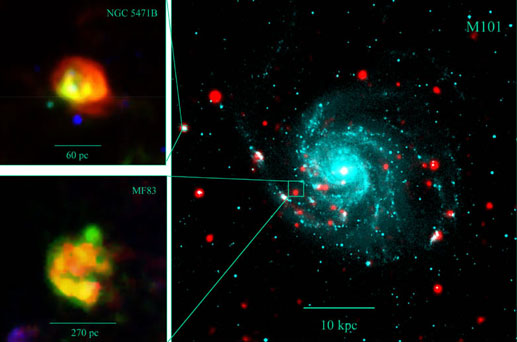Explanation: What created these huge explosion remnants? Speculation has been building recently that outbursts even more powerful than well-known supernovae might occur. Dubbed hypernovae, these explosions might result from high-mass stars and liberate perhaps ten times more energy than conventional supernovae. A hypernova was originally postulated to explain the great amount of energy seemingly liberated in a gamma-ray burst. A search for visible remnants of hypernovae has now yielded the above two candidates. Nearby spiral galaxy M101, shown on the right, has two large expanding shells that might have originated from a hypernova. Remnant NGC 5471B on the upper left and MF83 below were identified by the unusually high amount of X-ray radiation they emit. MF83 is also one of the largest expanding shells ever found. Research continues into the possible nature and visibility of hypernovae and the gas shells they likely leave behind.
1999 2000 2001 2002 2003 2004 2005 2006 2007 2008 2009 2010 2011 2012 2013 2014 2015 2016 2017 2018 2019 2020 2021 2022 2023 2024 2025 |
Yanvar' Fevral' Mart Aprel' Mai Iyun' Iyul' Avgust Sentyabr' Oktyabr' Noyabr' Dekabr' |
NASA Web Site Statements, Warnings, and Disclaimers
NASA Official: Jay Norris. Specific rights apply.
A service of: LHEA at NASA / GSFC
& Michigan Tech. U.
|
Publikacii s klyuchevymi slovami:
hypernova - supernova - gipernovaya - Sverhnovye
Publikacii so slovami: hypernova - supernova - gipernovaya - Sverhnovye | |
Sm. takzhe:
Vse publikacii na tu zhe temu >> | |
